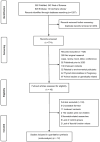Evaluation of thyroid function tests among children with neurological disorders
- PMID: 39717108
- PMCID: PMC11663650
- DOI: 10.3389/fendo.2024.1498788
Evaluation of thyroid function tests among children with neurological disorders
Abstract
Background: Thyroid hormones (THs) are essential for brain development. Numerous studies have identified significant links between thyroid dysfunction and cognitive function. However, research on the significance and necessity of thyroid function tests in diagnosis of neurological disorders is limited and subject to controversy.
Methods: Our study employed a combination of meta-analysis and case-control design. For the meta-analysis, we conducted a systematic search of online databases for studies that compared thyroid function tests in children with neurological disorders to controls. In our case-control study, we recruited a total of 11836 children, comprising 7035 cases and 4801 healthy controls. Wilcoxon Rank Sum Test was used to determine characteristics of thyroid function between the cases and healthy controls. In order to exclude the false discovery rate (FDR), the Benjamini-Hochberg (BH) procedure is applied.
Results: A total of 12 relevant literature sources were included in the meta-analysis. Compared with controls, free thyroxine (FT4) levels were significantly decreased in neurological disorders in meta-analysis (MD = -0.29, 95% CI: -0.50 to -0.09), whereas thyroid-stimulating hormone (TSH) levels showed no significant difference (MD = -0.07, 95% CI: -0.36 to 0.21). In our case-control study, levels of free thyroxine (FT4), total triiodothyronine (TT3), total thyroxine (TT4), and anti-thyroglobulin antibodies (TG-Ab) were notably reduced among individuals with neurological disorders, compared with healthy controls (P<0.001, P<0.001, P=0.036, P=0.006). However, thyroid-stimulating hormone (TSH) levels did not show any statistically significant differences among the cases and controls.
Conclusions: Our research demonstrates that, in comparison to controls, children with neurological disorders exhibited a significant decrease in FT4 levels, while TSH levels remained unchanged. This finding provides a reference for potential serum marker of neurological disorders in children. Replication in future studies with the assessment of THs is needed to determine whether thyroid function should be included as a routine screening in these children.
Keywords: attention deficit disorder with hyperactivity; autism spectrum disorder; children; neurological disorders; thyroid function tests.
Copyright © 2024 Meng, Bigambo, Gu, Wang and Li.
Conflict of interest statement
The authors declare that the research was conducted in the absence of any commercial or financial relationships that could be construed as a potential conflict of interest.
Figures






Similar articles
-
Clinical Parameters Are More Likely to Be Associated with Thyroid Hormone Levels than with Thyrotropin Levels: A Systematic Review and Meta-Analysis.Thyroid. 2020 Dec;30(12):1695-1709. doi: 10.1089/thy.2019.0535. Epub 2020 Jun 4. Thyroid. 2020. PMID: 32349628 Free PMC article.
-
[Thyroid gland and pregnancy--physiology and pathology].Wiad Lek. 2002;55(7-8):450-62. Wiad Lek. 2002. PMID: 12428574 Review. Polish.
-
Macro-TSH Interference in Thyroid Function Testing: a Case Report and Literature Review.Clin Lab. 2025 Apr 1;71(4). doi: 10.7754/Clin.Lab.2024.241048. Clin Lab. 2025. PMID: 40209789 Review.
-
Thyroid dysfunction in children with autism spectrum disorder is associated with folate receptor α autoimmune disorder.J Neuroendocrinol. 2017 Mar;29(3). doi: 10.1111/jne.12461. J Neuroendocrinol. 2017. PMID: 28199771
-
Evaluated reference intervals for serum free thyroxine and thyrotropin using the conventional outliner rejection test without regard to presence of thyroid antibodies and prevalence of thyroid dysfunction in Japanese subjects.Endocr J. 2009;56(9):1059-66. doi: 10.1507/endocrj.k09e-123. Epub 2009 Sep 9. Endocr J. 2009. PMID: 19738362
References
Publication types
MeSH terms
Substances
LinkOut - more resources
Full Text Sources
Medical
Miscellaneous

